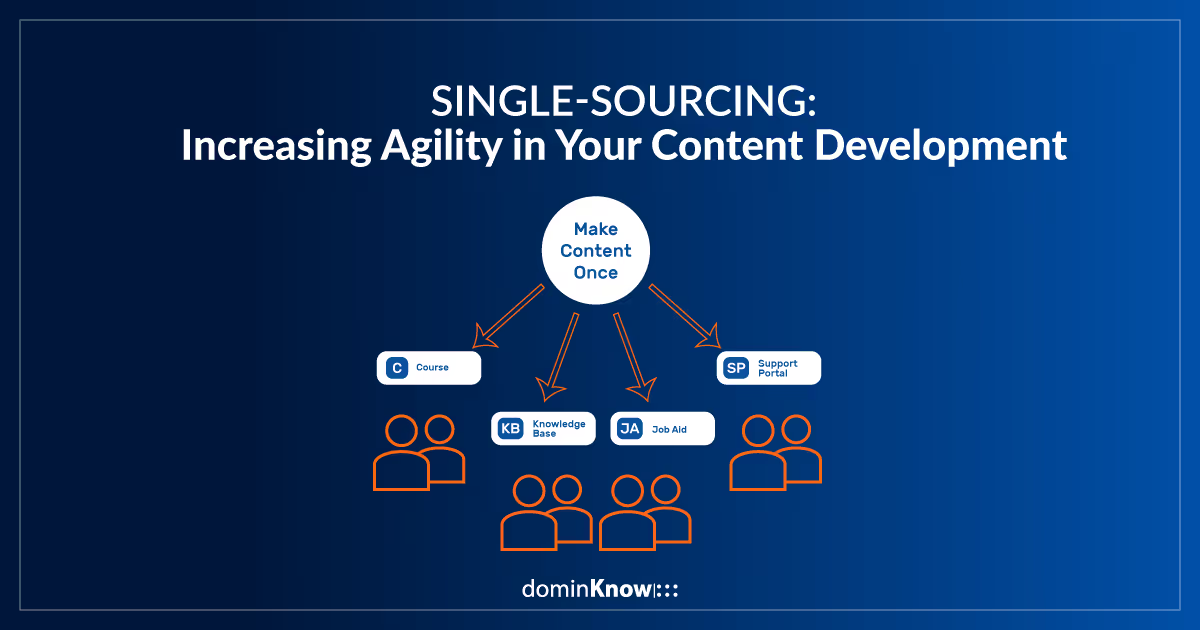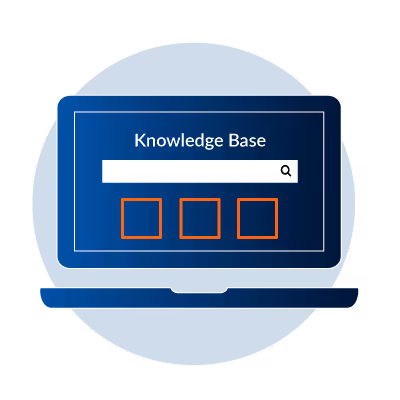Single-Sourcing: Increasing Agility in Your Content Development



In our last blog, we revealed why shifting your tools and processes can have a big impact on the agility of your L&D department. But there’s one essential topic we wanted to explore in a little more detail - single sourcing.
Below, we’re going to dig deeper into what single source content management is, what the benefits are, and how it can become an essential part of your organization.
What is single sourcing?
Put simply, single sourcing allows you to create learning content once and reuse it in many places without increasing effort. For instance, if you’re running a large, complex learning program, you may upload the same document in dozens of different places. Single source content management allows you to upload, reuse, update, and report on the asset from one place - in this case, a learning content management system (LCMS). Additionally, you can publish a single course across multiple channels simultaneously with very little effort, and maintaining multi-channel content is just as easy.
The benefits of single sourcing for content
The main benefits of adopting single source authoring is that your L&D team will reduce errors and save a significant amount of time. Instead of reuploading the same file into different courses, ending up with multiple variations of assets that become out of date and difficult to remedy, you can quickly make sweeping changes to courses containing the asset. This allows you to focus on collaborating with your team on required QA and approvals to push the learning content live across all your platforms with greater agility.
Single source authoring also means you can ensure the consistency of your content, as you will have one version of each asset, and each instance will be updated at once instead of being a manual task. This becomes critical when it comes to any compliance-related content that requires updates to align them with new rules and regulations.
It also empowers you to quickly scale your learning content management processes, as you can review, upload, and update content once to keep your entire program fresh and up to date.
Related Resources
.avif)
New to IDIODC?
Instructional Designers in Offices Drinking Coffee (#IDIODC) is a free weekly eLearning video cast and podcast that is Sponsored by dominknow.
Join us live – or later in your favourite app!
Try the most dynamic course authoring LCMS for free
3 valuable ways to leverage single sourcing for learning
Even if you’re sold on single sourcing as a concept, you may be wondering how it works in practice. Almost every organization delivering learning content can benefit from the ease and efficiency of single sourcing, but if you’re looking for specific single sourcing examples, we’ve got you covered.
1. Product documentation

Product documentation can encompass assets such as product manuals, user guides, step-by-step videos, technical documentation, and more. It’s vital to keep them up to date to support your employees and customers, but making even small updates can quickly add up to a lot of work if your product documentation lives in multiple places.
Single sourcing means you can work closely with your product or technical team to capture accurate information, check it for quality, then distribute it across the organization at the touch of a button. For instance, when your product interface changes, and you need to replace all your onboarding material for customers, sellers, and partners, you can do it once, instead of spending hours upon hours painstakingly tracking down and replacing individual assets.
This is especially useful if it lives on different systems and portals, as you don’t need to second-guess which version lives where, or whether you remembered to update each set of documentation.
2. Compliance documents

Compliance documents are some of the most important assets for any L&D team. In high-consequence industries, such as pharmaceuticals, finance, or manufacturing, one slip-up could have a huge impact, so it’s vital for organizations to keep track of their compliance materials.
Opting for single sourcing means that when regulations change, you can simply update the source document and update it everywhere. Your legal team can also ensure that your compliance documentation is up to standard, helping you pass your next audit with ease.
3. Internal knowledge base

Your employees may not always need formal training materials. Many questions can be answered by a simple search of your internal knowledge base, comprising a whole host of informal learning resources and information, such as tips and tricks, best practices, key statistics, handbooks, policy documents, guidelines, marketing materials, and more.
If each team (or department, or geographical location) has its own static documentation, version control can be almost impossible to maintain. Single source content management means you can ensure the consistency of all information stored within a central, multilingual knowledge base, so everyone gets exactly the same results for more accurate knowledge sharing and improved productivity… and it’s all natively achievable from the dominKnow | ONE LCMS! In fact, we use it ourselves for the user community, where you can find documentation on the product.
How OpenText uses single source authoring
dominKnow | ONE customer OpenText completely reversed its design and learning content creation process to a digital-first approach. Starting with eLearning content, OpenText can then repurpose this original asset as ILT (instructor-led training) content and just-in-time performance support with dominKnow | ONE’s single sourcing methodology. They create the content once and publish it in multiple formats from a single platform, saving time, money, and effort.
Thanks to dominKnow | ONE’s single-source synchronized content model, OpenText can also share learning assets across many different projects, while keeping that content updated across the board. All eLearning courses and job aids managed within dominKnow | ONE remain automatically updated together to maximize operational efficiency - in fact, this new approach has accelerated course creation from producing one course every 3 to 6 months to producing one within weeks, thanks in part to the efficiencies of single sourcing.
dominKnow has all the tools your team needs to create and distribute knowledge wherever and whenever it’s needed.



.svg)






